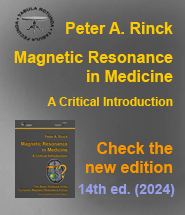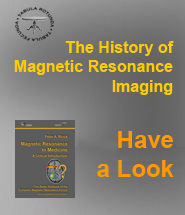Glosario
| a | b | c | d | e | f | g | h | i | j | k | l | m | n | o | p | q | r | s | t | u | v | w | x | y | z |
P
Paradoxical enhancement: the unpredicted change of signal intensity of vessels with flowing blood in multislice imaging.
Paramagnetic: a substance with a small but positive magnetic susceptibility (magnetizability). The addition of a small amount of paramagnetic substance may greatly reduce the relaxation times of water. Typical paramagnetic substances usually possess an unpaired electron and include atoms or ions of transition elements, rare earth elements, some metals, and some molecules including molecular oxygen and free radicals. Paramagnetic gadolinium chelate complexes are used as T1 contrast agents in MRI.
Partial saturation (PS): excitation technique applying repeated RF pulses in times on the order of or shorter than T1. In magnetic resonance imaging systems, although it results in decreased signal amplitude, there is the possibility of generating images with increased contrast between regions with different relaxation times. Produces proton density- and T1-weighted images. The change in NMR signal from a region resulting from a change in the interpulse time, TR, can be used to calculate T1 for the region. Although partial saturation is also commonly referred to as saturation recovery, that term should properly be reserved for the particular case of partial saturation in which recovery after each excitation effectively takes place from true saturation. PS (SR) images usually have poor image contrast.
Permanent magnet: a magnet whose magnetic field originates from permanently magnetized material.
Permeability (μ): tendency of a substance to concentrate magnetic field μ = B/H.
PFGSE NMR → Pulsed Field Gradient, Spin Echo NMR.
Phantom: an artificial object of known dimensions and properties used to test aspects of an imaging machine.
Phase: in a periodic function (such as rotational or sinusoidal motion), the position relative to a particular part of the cycle.
Phase encoding: the application of a gradient prior to recording an NMR signal encodes the signal with a phase which depends on the strength of the gradient, the duration of the gradient and the position of the spins. Acquiring a series of signals with different amounts of phase encoding, followed by a Fourier transform allows the positional information to be decoded.
Phase rewinder gradient: a gradient which is applied after data collection and has equal amplitude but opposite polarity to the normal phase encoding gradient. Ensures that each interpulse interval produces the same net phase, allowing transverse coherences to develop uniformly across the whole field of view.
Phase sensitive detector → Demodulator.
Pixel: acronym for picture element; the smallest discrete part of a digital image display.
Planar spin imaging: one particular technique of planar imaging that creates an NMR image of a plane from one excitation sequence by selectively exciting a grid of points within the plane and then applying a gradient magnetic field so that each point has a different Larmor frequency. Fourier transformation of the FID can then be used to separate the signals from each selected point and create the image.
Planar imaging: imaging technique in which the image of a plane is built up from signals received from the whole plane. (→ Sequential plane imaging).
Point imaging → Sequential point imaging.
Point scanning → Sequential point imaging.
Polarisation transfer: a technique for transferring magnetization from proton to strongly coupled nuclei and hence improving the S/N ratio of the other (less sensitive) nuclei.
ppm: part(s) per million.
Precession: comparatively slow gyration of the axis of a spinning body so as to trace out a cone; caused by the application of a torque tending to change the direction of the rotation axis, and continuously directed at right angles to the plane of the torque. The magnetic moment of a nucleus with spin will experience such a torque when inclined at an angle to the magnetic field, resulting in precession at the Larmor frequency. A familiar example is the effect of gravity on the motion of a spinning top or gyroscope.
Precessional frequency → Larmor frequency.
Presaturation: an excitation pulse followed by a spoiler gradient which is used to remove the signal from a particular part of a spectrum or imaging volume.
PRESS: a technique for localized spectroscopy using a spin echo sequence.
Probe: the portion of an NMR spectrometer comprising the RF coils and some associated electronics. The RF coils may consist of separate receiver and transmitter coils in a crossed-coil configuration, or, alternatively, a single coil to perform both functions.
Program → Software.
Progressive saturation → Saturation recovery.
Projection profile spectrum of NMR signal whose frequency components are broadened by a gradient magnetic field. In the simplest case (negligible line width, no relaxation effects, and no effects of prior gradients), it corresponds to a one-dimensional projection of the spin density along the direction of the gradient.
Proton density: (also: rho or ρ) the spin density of hydrogen-1 (1H) spins; represents to a certain extent the water content of a sample or a tissue in proton magnetic resonance imaging.
Proton density-weighted image (also: rho- or ρ-weighted image): image whose contrast is mainly influenced by proton density, but which also has T1, T2, and bulk flow contributions. Usually used as a synonym of spin density, although this only applies for hydrogen. Better term: intermediately (between T1 and T2) weighted.
PS → Partial saturation.
PSIF → CE-FLASH.
Pulse, 90° (π/2 pulse): RF pulse designed to rotate the macroscopic magnetization vector 90° in space as referred to the rotating frame of reference, usually about an axis at right angles to the main magnetic field. If the spins are initially aligned with the magnetic field, this pulse will produce transverse magnetization and hence an FID.
Pulse, 180° (π pulse): RF pulse designed to rotate the macroscopic magnetization vector 180° in space as referred to the rotating frame of reference, usually about an axis at right angles to the main magnetic field. If the spins are initially aligned with the magnetic field, this pulse will produce inversion, for transverse magnetization causes a phase change which leads to the generation of a spin echo.
Pulse length (width): time duration of a pulse. For an RF pulse near the Larmor frequency, the longer the pulse length, the greater the angle of rotation of the macroscopic magnetization vector will be (greater than 180° can bring it back toward its original orientation).
Pulse programmer: part of the spectrometer or interface that controls the timing, duration, and amplitude of the pulses (RF or gradient).
Pulse sequences: set of RF (and/or gradient) magnetic field pulses and time spacing between these pulses; used in conjunction with gradient magnetic fields and NMR signal reception to produce NMR images. See also Interpulse times.
Pulsed Field Gradient, Spin Echo NMR (PFGSE NMR): diffusion measurement technique with short pulsed gradients separated by a well-defined diffusion time.
Pulsed gradients → Gradient pulse.
Pulsed NMR/MR: NMR/MR techniques that use RF pulses and Fourier transformation of the NMR signal; have largely replaced the older continuous wave techniques.
Missing terms? Send us an e-mail. We'll add them ...












